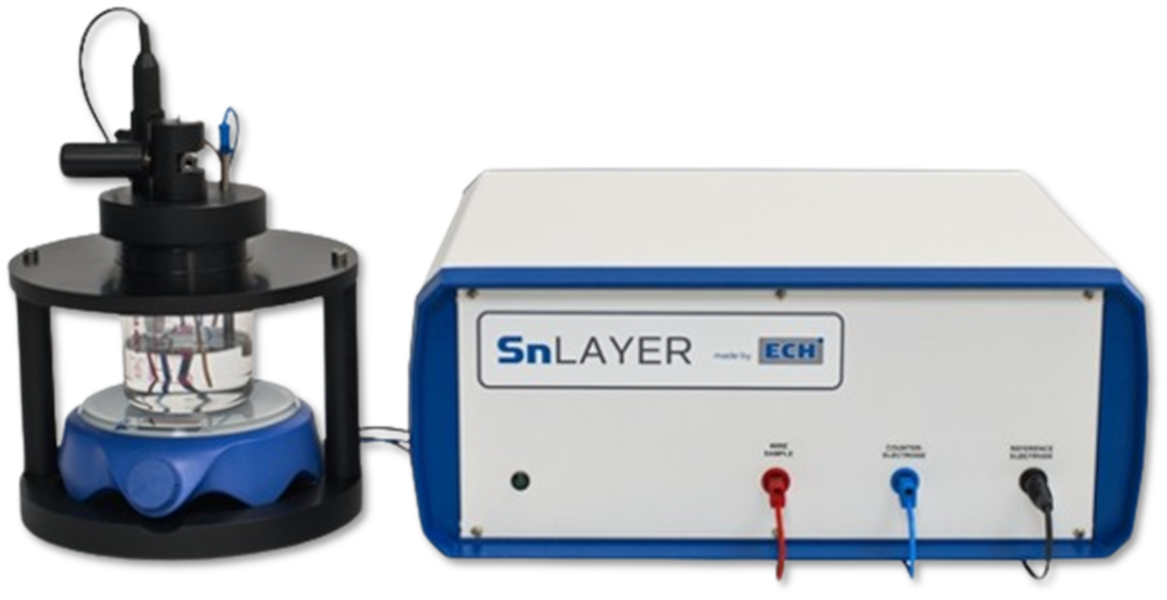SnLayer
High-Precision Coating Thickness Measurement on Metals

Product description
When coating metals, even the thinnest layers can achieve the desired functional effect. However, these layers must be applied uniformly to ensure optimal electrical performance and long-term stability. Any excess coating not only wastes valuable materials but also significantly increases costs.
The SnLAYER analysis system from ECH offers a fast and highly accurate solution for determining coating thickness on metallic surfaces – all with a single measurement.
Innovative Electrochemical Technology
SnLAYER is based on a newly developed electrochemical method using coulometric voltammetry, fully aligned with DIN 1787 and DIN 40500, Part 5.
The patented potential scan method enables the simultaneous detection of both free and alloyed portions of the coating – for example, tin layers on copper substrates.
Fast, Reliable Results
A typical analysis takes less than five minutes, delivering precise results that help optimize material usage, ensure quality, and reduce costs in production processes.

Applications

Measurement of tin layer thickness on copper wires, copper sheets, wire strands

Determination of alloyed and unalloyed tin

Analysis of nickel, silver, copper and alloys on copper, steel, Percon and others

Conductor board manufacture

Wire and cable manufacture

Applications in the metalworking industry

SnLAYER for determination of thickness of metal layers

Advantages

Complete measurement system for determination of the layer thickness of metal coatings

Differentiation of free and bounded tin

Fast analysis

Customer-friendly handling

Intuitive software

Comprehensive statistic module

Wide dynamic range for various wire-diameters and layer thickness

Universally applicable for different types of layers

Features and Results

Typical duration: 8 min (non-alloyed and alloyed tin), < 2 min (non-alloyed tin)

High precision of the analysis

Currency will be registered in the provided potential range, freely adjustable in a range from - 2000 mV to + 2000 mV, e. g. - 600 mV up to + 300 mV

Pre-defined methods specified for certain wire types

Generation of individual methods

Determination of the mass of the coating by integration of the current (amount of electric charge)

Automatic procedures

Determination of the thickness with only one measurement with high precision in a short duration

According to the actual standard regulations

Coulometric measuring cell - the sample is the working electrode

Software requirements
Operating system | Windows 10 or higher |
Platform | 32 Bit (x86) |
CPU | 1 Ghz |
RAM | 1 GB |
HDD / SSD | 17 GB |
GPU | DirectX 9 with WDDM 1.0 |
Available languages | German, English |
Number of connections | 1 |
Data connection | USB-B to USB-A |

Typical measurement - automatic peak analysis / interpretation

Technical specifications
Device Type | Main unit |
Power supply | 230 V/50 Hz or 110 V/60 Hz |
Power Input | 150 W |
Dimensions (W x H x D) | 370 x 345 x 160 mm |
Weight | 6 kg |
Data connection | USB-B |
Device control | PC Software |
| Working electrode | Wire or strip sample to be examined |
| Reference electrode | Ag/AgCl adapted to the application |
| Counter electrode | Pt |
| Typical duration | 2 ... 8 min (depending on the layer thickness) |
| Typical wire diameters | 0.05 ... 8 mm |
| Typical layer thicknesses | 0.01 ... 22 µm |
